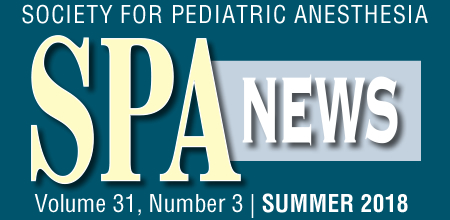PRO/CON
CON
Against Cuffed Endotracheal Tubes in the Infant and Neonatal Population
By Nicole Dobija, MD and Michael Puglia, MD
Mott Children’s Hospital
University of Michigan
Prior to the turn of the century (circa 2000’s) it was standard practice to use uncuffed endotracheal tubes (ETT) while ventilating patients under eight years of age, with the belief that the cricoid cartilage is the narrowest portion of the pediatric airway. (1,2) The concern was that a cuffed ETT may cause mucosal damage from excessive pressure in this nondistensible and vulnerable area, with resultant subglottic stenosis. With the introduction of the HVLP (high volume low pressure endotracheal tubes) in the late 1990’s and the Microcuff (Kimberley Clark) pediatric endotracheal tube in 2004, more pediatric anesthesiologists have been incorporating cuffed ETT’s into their practice for the pediatric patient population. While the previous authors describe this as safe for pediatric patients, is this the most prudent practice for our youngest and most vulnerable patients: infants and neonates?
Conventional airway teaching has evolved, thanks to recent studies showing that the pediatric airway is cylindrical and not funnel shaped and that the cricoid area is not round but elliptical. (3,4,5) We (pediatric anesthesiologists) have incorporated this into our teaching and adapted our practice to more liberal use of cuffed endotracheal tubes. What the previous authors fail to mention is the number of infants and neonates in these studies is relatively small.
In Litman et al’s MRI study from 2003, there were 99 children, ages two months to 14 years of age, with a mean age of 61 months. They showed that the cricoid was not the narrowest portion of the airway as previously believed but the vocal cords, similar to adult patients. However, they did not report how many of these patients were one year and below. Using rigid bronchoscopy to evaluate the size of the glottic and cricoid area, Dalal et al (2008) confirmed Litman’s findings that the glottic opening had a smaller area than the cricoid area. They also detailed the elliptical nature of the larynx with the anterior-posterior dimension being the longest. Their study included 27 patients with a mean age of 73 months. Again, the number of neonates and infants included in the study is not specified.
In a subsequent study (2009), Dalal evaluated the airway of 128 patients from six months to 13 years of age. Only 13 of the 128 patients were six months to two years of age and there were no patients less than six months of age. While we do not dispute any of this new evidence, we must keep in mind that there are very little data supporting the use of cuffed ETT’s in the infant and neonatal populations.
While the use of cuffed endotracheal tubes has greatly reduced the number of reintubations due to excessive air leak with ventilation, this may be more of an issue in the patient population that has a larger weight and age disparity, i.e. the one-to-eight year old population. Khine et al (6) compared cuffed and uncuffed ETT in young children. While some infants were included in this study, differences in reintubation rate or the presence or not of an airway leak were not reported in this subset. Weiss et al (7) showed an increase in postoperative stridor in the cuffed group vs the uncuffed group of 6.1% vs 3.4% in the 8 month to 18 month of age group. Mahmoud et al’s neonatal intensive care study (8) showed that 42.3% of uncuffed ETT’s experience a leak of >40% at some point. What was not mentioned was that this leak was most commonly experienced after three days of remaining intubated suggesting that cuffed ETTs are not necessary for the majority of the infants we encounter in the operating room setting.
In 2013, Sathyamoorthy et al published a case series of neonates experiencing postoperative stridor after intubations with a microcuff endotracheal tube. (9) These data highlight the need for vigilance with appropriate selection of size of cuffed endotracheal tubes, and that microcuff ETT are not immune to complications. In this same issues of “Anesthesiology,” Drs. Litman and Maxwell state that there is no longer a role for the uncuffed endotracheal tube beyond the neonatal period. (10) They also state that there needs to be more research performed on optimizing endotracheal tube standards in the neonatal period.
While cuffed endotracheal tubes are being increasingly used in our smallest patients in the operating room setting, neonatal intensive care units (NICU) have been slower to adopt this practice. Thomas et al (11) evaluated NICU and pediatric intensive care unit (PICU) usage of cuffed endotracheal tubes in neonates >3kg and <3kg. This survey showed that 66% of NICU's in Australia and New Zealand never use cuffed ETT's and that cuffed ETT's were never used in the perinatal NICU's. Thomas et al (12) then went on to evaluate 23 neonates <3 kg intubated with a microcuff ETT or an uncuffed ETT. There were no significant differences in the rates of: needing to change the endotracheal tube to find correct size, median ventilator leak, unplanned extubations or post extubation stridor. The median intubation duration was one day and the cuff was deflated in the NICU even if it was inflated in the operating room.
Although small, this study shows that in this <3kg population there is no difference in using a cuffed vs uncuffed ETT. The use of an uncuffed ETT, permits the use of a larger uncuffed ETT which may increase the ability to suction, decrease the work of breathing and avoid the increased cost of using a microcuff endotracheal tube. There is little research evaluating cuffed endotracheal tubes in the NICU environment. These are our most vulnerable patients that can have severe complications from tracheal stenosis. Whether we use a cuffed or an uncuffed endotracheal tube we must remain vigilant with its placement and manipulation to prevent any inadvertent injury to the laryngeal tissues.
In 2017, a Cochrane data base review was unable to draw conclusions comparing cuffed and uncuffed endotracheal tubes in children aged 8 years and under undergoing general anesthesia. (13) They stated that the published studies were biased and offered little information on the complications from either type of endotracheal tube.
Uncuffed ETTs are usually selected with an inner diameter (ID) of 0.5mm larger than cuffed ETTs (i.e. a 3.5 ID uncuffed v. 3.0 ID cuffed). The increased ability to suction, manipulate a fiber-optic scope while oxygenating or ventilating, and resistance to kinking are not trivial differences when we push the limits of our equipment in our smallest and most vulnerable patients. Furthermore, the academic argument of flow from Hagen-Poiseuille law states that the change in pressure varies linearly with length and to the fourth power with the radius (this assumes non-compressibility and laminar flow). From practical studies, the resistance could be decreased approximately 75% by using an ETT with ID of 3.5 v. 2.5 (14). This is usually well compensated by modern ventilators; however, during periods of spontaneous ventilation without pressure support, the work of breathing is significantly higher in these children with smaller diameter tubes (and especially with those < 4.0mm).
Most pediatric anesthesiologists use cuffed endotracheal tubes in the under eight years of age population. However, when selecting an ETT for the infant and neonatal patients who may be vulnerable to airway injury, important factors such as postoperative ventilation, airway manipulation in the post-operative period, and NICU management of cuffed ETT’s merit consideration. Endotracheal tube selection is definitely not a one size fits all option and should not be one type fits all either!
References
- Eckenhoff JE. Some anatomic considerations of the infant larynx influencing endotracheal anesthesia. Anesthesiology. 1951;12(4):401-410
- Bayeux. Tubage de larynx dans le croup. Presse med 1897; 20:1.
- Litman RS, Weissend EE, Shibata D, Westesson P-L. Developmental changes of laryngeal dimensions in unparalyzed, sedated children. Anesth Analg 2003; 98:41–5.
- Dalal PG, Murray D, Feng A, Molter D, McAllister J. Upper airway dimensions in children using rigid video-bronchoscopy and a computer software: description of a measurement technique. Pediatr Anesth 2008; 18:645–53.
- Dalal PG, Murray D, Messner AH, Feng A, McAllister J, Molter D. Pediatric laryngeal dimensions: an age-based analysis. Anesth Analg 2009;108:1475–9
- Khine HH, Corddry DH, Kettrick RG, et al. Comparison of cuffed and uncuffed endotracheal tubes in young children during general anesthesia. Anesthesiology 1997; 86: 627–31
- Weiss M, Dullenkopf A, Fischer JE, et al. Prospective randomized controlled multi-centre trial of cuffed or uncuffed endotracheal tubes in small children. British Journal of Anaesthesia 2009;103:867–73
- Mahmoud RA, Proquitte H, Fawzy N et al. Tracheal tube air leak in clinical practice and impact on tidal volume measurements in ventilated neonates. Pediatric Critical Care Medicine 2011; 12:197-202.
- Sathyamoorthy MK, Lerman J, Lakshminrusimha S, Feldman D: Inspiratory stridor after tracheal intubation with a Microcuff® tracheal tube in three young infants. Anesthesiology 2013; 118:748–50
- Litman RS, Maxwell LG: Cuffed versus uncuffed endotracheal tubes in pediatric anesthesia: the debate should finally end. Anesthesiology. 2013 Mar;118(3):500-1.
- Thomas R, Rao S, Minutillo C. Cuffed endotracheal tubes in neonates and infants: a survey of practice Archives of Disease in Childhood - Fetal and Neonatal Edition 2016;101:F181-F182.
- Thomas RE, Rao SC, Minutillo C, Hullett B, Bulsara MK. Cuffed endotracheal tubes in infants less than 3 kg: A retrospective cohort study. Pediatr Anesth. 2018;28:204–209.
- De Orange FA, Andrade RG, Lemos A, Borges PS, Figueiroa JN, Kovatsis PG. Cuffed versus uncuffed endotracheal tubes for general anaesthesia in children aged eight years and under. Cochrane Database Syst Rev. 2017 Nov 17;11
- Manczur T, Greenough A, Nicholson GP, et al. Resistance of pediatric and neonatal endotracheal tubes: influence of flow rate, size, and shape. Crit Care Med 2000;28(5):1595-1598.






